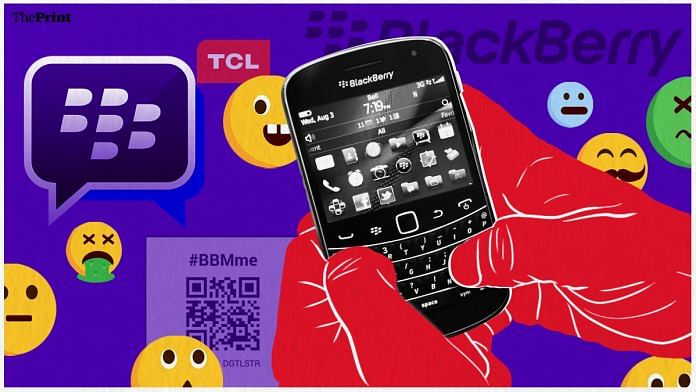New Delhi: “Can you BBM that to me?”, “Hey, what’s your BBM pin?” — these were some of the common phrases heard during the mid-2000s to early 2010 as many young adults started using an emoji-laden, instant messaging app on their mobile phones.
BBM, which stands for BlackBerry Messenger, became the dominant mode of communication for a short period of time before WhatsApp took over our phones.
BBM operated as an instant messaging platform exclusively for BlackBerry devices, which operated on the Blackberry OS (operating system). Later, BBM was also available on the Apple and Google Play stores.
“BBM was central to Blackberry’s popularity in the consumer market, especially with the youth and businesspersons,” a former senior executive with BlackBerry India, who did not wish to be named, told ThePrint.
“The ability to instantly message someone from your mobile, with a better interface than text messaging, made it a unique brand at the time,” the executive added.
In 2014, BBM had 150 million active users. However, when it stopped operations in 2019, it had very few active users.
Nevertheless, BBM’s dominance at the time can be viewed as a transitional period in the world of communication, when instant messaging shifted from the desktop or laptop to the QWERTY keypad. A QWERTY keypad is the “standard typewriter and computer keyboard in countries that use Latin-based alphabet”.
BBM was the bridge between the worlds of MSN messenger, Orkut and Facebook, before WhatsApp took over.
Also read: Chacha Chaudhary — Indian comic book hero who broke masculine archetypes like Superman, Batman
‘BBMing’ in real-time
“The thrill of coming back from college and BBM a friend in real-time made the app special,” reminisced Mayank Sanwalka, a food consultant based in Dubai. “The ability to chat with friends on a group, share emoticons, as emojis were called back then, also made BBM such a unique platform during the mid-2000s,” he added.
Unlike WhatsApp, BBM did not operate on an individual’s mobile number. Each handset and anyone who downloaded the app had a unique BBM pin. This pin was essential to add someone on the app and then chat.
“When someone new would join BBM, invariably their friends would broadcast their pin to all contacts so that everyone could connect with the person,” said Sanwalka.
BBM created a platform that offered an exciting, interactive, and distinct mode of communication. This was central to its popularity among the youth.
BBM in business
BBMs popularity, though, wasn’t limited to college goers. It was central to business life too.
The Financial Times had described BBM and the Blackberry handset as “the ultimate business gadget no self-respecting chief executive could be without”.
“During a typical day at a corporate office in the mid-2000s, you would see executives prancing about the office while having their Blackberry’s glued to their thumbs. Either firing off a quick email or sending communiques on BBM groups,” Rupinder Mangat, an entrepreneur based in London, told ThePrint
Such was the prevalence of BBM and the BlackBerry handset in corporate and business life that terms like “crackberry” and “BlackBerry thumb” were used to describe users. The former was a reference to those executives who were constantly using the device for work, and the latter was a knock-on effect of excessive use of the handset, resulting in a sore thumb.
Exclusivity — charm or cause of downfall?
A central feature of BBM till 2013 was its exclusivity to BlackBerry users. Avery Hartmans, senior reporter for Insider, said, “BBM added you to that really exclusive club of BlackBerry-only users.”
While the exclusivity added to BBM’s charm and played a central role in increasing sales of Blackberry handsets in the initial years after its launch, it did set a clear ceiling for the brand. The onset of other instant messaging apps like WhatsApp, which were available for free on the Apple and Google Play stores, derailed BBM’s growth.
“BBM slowly fizzled away because BlackBerry was behind the curve in allowing BBM to be available on other app stores and operating systems. BlackBerry also failed to move BlackBerry’s operating system to an open platform. This left the field for WhatsApp to take over,” explained the former senior executive at BlackBerry India.
Even though BlackBerry stopped operations for BBM in 2019, the app heralded a transformational period for instant messaging and communication. Beyond catering to business executives and college-going students, the app also left a significant mark on the popular urban culture of the mid-2000s to 2010s.
The emoticons (now called emojis), the ‘ping’ sound reminding an user to reply, the trackball, and the BBM pin were all unique to the app and found representation in TV shows and cinema.
Also read: Radio Ceylon — the Sri Lankan channel India turned to when AIR banned film music in 1952



